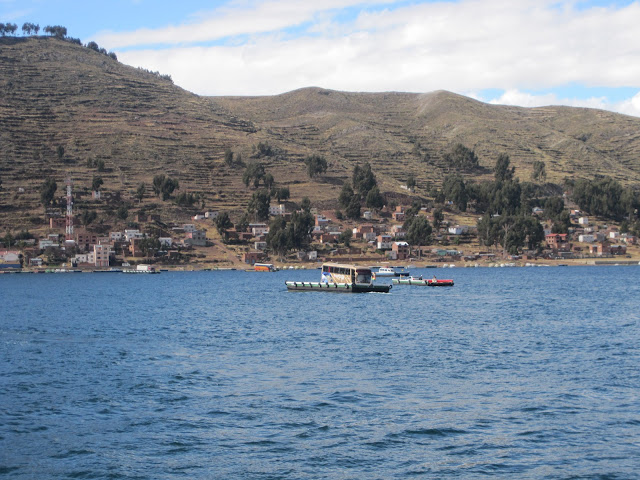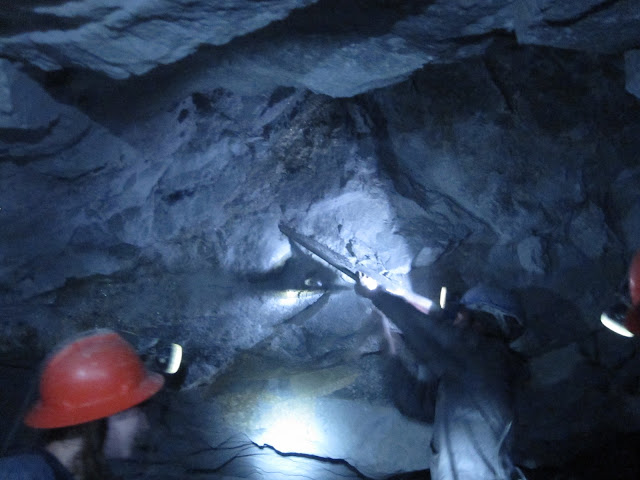Buses in Bolivia are kind of like getting a kinder egg, there is always a surprise waiting for you. We took a bus from Puno in Peru to the border with Bolivia and from there another bus to La Paz. This was my first Bolivian bus experience, not the most comfortable bus in the world but still it was a bus and it didn't break down. The surprise on this trip was the stop to take a boat across the river. One boat for the bus and a small passenger bus for us. No one had mentioned this to us or anyone else on the bus.
Later in the bus journey everyone was required to pay a mysterious 1 bolivian tax. We even got a receipt for it but there was no indication as to what it was for even when questioned.
The next bus was a night bus from La Paz to Potosi. I think this may be the worst bus that I've ever taken. My experience of night buses throughout latin america is that they are generally cold so extra warm clothing is a must. When we were buying our ticket a girl queueing in front asked if it would be cold on the bus, she was assured that it would be warm and that she'd have a blanket too. We still took our warm clothes as I didn't trust them. The bus was freezing even with a fleece, a jacket, a scarf, a hat and a blanket. We took a cama bus, meaning a bus with a bed but the definition of cama, semi cama and regular bus seem to be used interchangeably in Boliva. The bus driver also let some locals on who sat or slept in the isle of the bus. To me this looked like a pretty painful way to travel. At the time I did not know that I'd be sitting in the isle of a bus a few days later.
Next was a 5 hour bus from Potosi to Uyuni. This was a day bus but it was still freezing, the windows didn't close and that combined with me not having a seat and having to sit in the isle made for a pleasant journey. The bus was full including the isle with people sitting and standing yet at every opportunity to stop the bus driver picked up more passengers and squashed them in. It could have been worse, at least it was only 5 hours and not a night bus.
After these bus experiences we did some more research for our night bus from Uyuni to La Paz. There were no 'cama' buses only 'semi cama' but we were assured that the bus had heating. The temperature in Uyuni was about -10 so heating would be essential. Surprisingly the bus didn't have any heat but at this stage we knew not to trust what they tell you so we were prepared. Hats, scarfs, gloves, extra socks, t-shirts and jumpers what we had not anticipated was the lack of road between Uyuni and La Paz. Around 3 am the road disappeared and the bus continued at full speed along an off-road track for at least an hour. The shaking and the pain was relentless and intense. I did forget to mention that we were sitting in the back seat which didn't recline at all, so much for 'semi cama'.
My last bus journey in Bolivia was an 18 hour semi cama night bus from La Paz to Villazon. I knew this was going to be a long painful trip so I did my research at the bus station, checked out the buses and went with what appeared to be the best - relatively new buses, semi cama, dvd's and a toilet. All of which were confirmed, I even saw photos and was able to choose my seat. As requested I arrived a half hour before my bus was due to depart, at which point my ticket was changed for another ticket. Turns out I'd be traveling with Panamericana, one of the bus companies that I was avoiding. From what I could see all of the other bus companies were just reselling tickets for Panamericana. So much for the photos. 18 hours on a cramped bus with no leg room, no heating, no toilet and broken windows so there is a constant draft coming in! At about 1 am we had a toilet stop, there weren't actually any toilets, we just stopped in the middle of no where.
 |
| Boats for Buses |
 |
| Bus on a boat |
Later in the bus journey everyone was required to pay a mysterious 1 bolivian tax. We even got a receipt for it but there was no indication as to what it was for even when questioned.
The next bus was a night bus from La Paz to Potosi. I think this may be the worst bus that I've ever taken. My experience of night buses throughout latin america is that they are generally cold so extra warm clothing is a must. When we were buying our ticket a girl queueing in front asked if it would be cold on the bus, she was assured that it would be warm and that she'd have a blanket too. We still took our warm clothes as I didn't trust them. The bus was freezing even with a fleece, a jacket, a scarf, a hat and a blanket. We took a cama bus, meaning a bus with a bed but the definition of cama, semi cama and regular bus seem to be used interchangeably in Boliva. The bus driver also let some locals on who sat or slept in the isle of the bus. To me this looked like a pretty painful way to travel. At the time I did not know that I'd be sitting in the isle of a bus a few days later.
Next was a 5 hour bus from Potosi to Uyuni. This was a day bus but it was still freezing, the windows didn't close and that combined with me not having a seat and having to sit in the isle made for a pleasant journey. The bus was full including the isle with people sitting and standing yet at every opportunity to stop the bus driver picked up more passengers and squashed them in. It could have been worse, at least it was only 5 hours and not a night bus.
After these bus experiences we did some more research for our night bus from Uyuni to La Paz. There were no 'cama' buses only 'semi cama' but we were assured that the bus had heating. The temperature in Uyuni was about -10 so heating would be essential. Surprisingly the bus didn't have any heat but at this stage we knew not to trust what they tell you so we were prepared. Hats, scarfs, gloves, extra socks, t-shirts and jumpers what we had not anticipated was the lack of road between Uyuni and La Paz. Around 3 am the road disappeared and the bus continued at full speed along an off-road track for at least an hour. The shaking and the pain was relentless and intense. I did forget to mention that we were sitting in the back seat which didn't recline at all, so much for 'semi cama'.
My last bus journey in Bolivia was an 18 hour semi cama night bus from La Paz to Villazon. I knew this was going to be a long painful trip so I did my research at the bus station, checked out the buses and went with what appeared to be the best - relatively new buses, semi cama, dvd's and a toilet. All of which were confirmed, I even saw photos and was able to choose my seat. As requested I arrived a half hour before my bus was due to depart, at which point my ticket was changed for another ticket. Turns out I'd be traveling with Panamericana, one of the bus companies that I was avoiding. From what I could see all of the other bus companies were just reselling tickets for Panamericana. So much for the photos. 18 hours on a cramped bus with no leg room, no heating, no toilet and broken windows so there is a constant draft coming in! At about 1 am we had a toilet stop, there weren't actually any toilets, we just stopped in the middle of no where.





















































